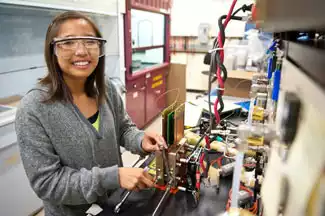Embed Geoscience Careers in the Curriculum

Illuminate Geoscience Careers
Many students have never met a geoscientist beyond their instructor. Even if they have a sense of some more "visible" geoscience-related careers in mining, petroleum, or environmental fields, they may not recognize the diversity of career options available in both the public and private sectors.
Becca Walker began partnering with the Mt. SAC STEM Center in winter 2019 to offer a series of workshops related to careers and professional pathways.
Elizabeth Nagy developed a geoscience career project that gets students to interview actual geoscientists.
Karen Layou embedded career information into her courses through images of diverse geoscientists, casual descriptions of subdisciplines of geoscience, scientists spotlight activities, and encouraging student participation in geoscience conferences.
Help Students Develop a Science Identity
Develop Students'
Science Identity »
Introductory geoscience courses commonly have a mix of science and non-science degree seeking students looking to fulfill general education requirements. Showcasing geoscientist biographical sketches can help students see scientists as regular people and envision themselves in those careers. Encouraging all students to see themselves in the role of a geoscientist is a way to increase their science identity which can also contribute to a student's sense of belonging in the discipline.
Dave Voorhees developed an extra credit project offered to students that asked them to produce and create a short video on an underrepresented minority or woman geoscientist. The submitted videos are available on the course's YouTube channel.
In this post for the SAGE Musings Blog, Change Agent Lynsey Lemay describes how she went about incorporating an attention to building science identity into her oceanography course at Thomas Nelson Community College.
Bryn Benford initiated a semester-long project involving her building's three-story rock wall, so that students get the experience of going to outcrops, collecting data, and making interpretations from that data.
Clarify Pathways to Geoscience Careers
Once students have identified a curiosity about geoscience careers, it is important to show them ways to reach their goals. There are many options, each requiring different levels of academic preparation. Helping students isolate what interests them can allow them to develop plans for their immediate and long-term goals.
The Southern California 1 team has made great strides towards developing a Geotechnician Certificate Program to complement the college's Career and Technical Education (CTE) program. The team wrote about their program for the NAGT Geo2YC Newsletter.
The Southern California 3 team worked with Pasadena City College's academic counselors to develop curriculum transfer maps to help students get through the system in two years.